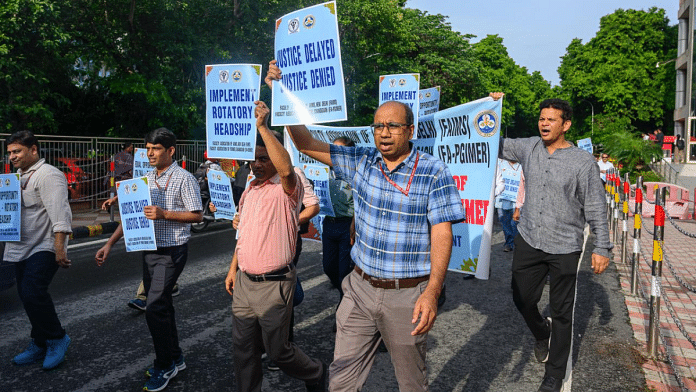Thank you dear subscribers, we are overwhelmed with your response.
Your Turn is a unique section from ThePrint featuring points of view from its subscribers. If you are a subscriber, have a point of view, please send it to us. If not, do subscribe here: https://theprint.in/subscribe/
Every year, thousands of young doctors in India complete their MBBS or post-graduation after years of sleepless nights and personal sacrifice. But instead of starting their careers freely, many are forced into mandatory service bonds — usually one or two years in a government hospital — or must pay heavy penalties running into lakhs of rupees.
The bond system was created to address doctor shortages in rural areas, a genuine problem. Yet in its current form, it has become unfair, outdated, and poorly designed, especially for students from private medical colleges who receive no government subsidy.
What Is a Bond?
Most state governments require medical graduates to work in a public hospital after finishing MBBS or PG. If they don’t, they must pay a penalty. The rules vary by state.
- Maharashtra: 1-year bond for MBBS and 1-year for PG, with ₹10–50 lakh penalty.
- Tamil Nadu: 2-year bond for PG doctors.
- Madhya Pradesh, Gujarat, Karnataka: similar policies with varying fines.
These bonds apply to both government and private medical college graduates, even though the financial background and fee structures are completely different.
One Rule, Two Realities
Government medical students pay minimal fees — often less than ₹1 lakh a year — because taxpayers subsidize their training. Expecting them to serve in government hospitals is fair.
But private college students pay between ₹15–25 lakh per year for MBBS, sometimes even more for postgraduate seats. They fund their own education entirely, receive no financial aid, and get no preference in government exams or postings. Yet they are forced to serve the same bond or pay the same penalty as government college students.
That’s like paying full price for your education and still being told you owe a debt to the government.
The Logic That Doesn’t Add Up
The usual justification is that doctors must “give back to society.” But this logic is applied only to one profession.
IIT and IIM graduates also receive heavily subsidized education. They use taxpayer money too — yet no one asks them to serve in public-sector industries or rural businesses after graduation. They are free to take high-paying jobs abroad or in private firms.
If bonds are truly about returning the favour of subsidy, then government-funded students — not private ones — should bear that responsibility. But the opposite is happening. This selective enforcement makes the system appear biased and unreasonable.
Why the Bond System Fails in Practice
Even where the intent is noble, the bond policy often fails on the ground.
Bonded doctors are frequently posted in remote hospitals with:
- Poor infrastructure and limited medicines
- No senior supervision
- Unsafe or inadequate accommodation
- Delayed salaries and poor working conditions
Instead of helping rural health services, it demotivates young doctors. Many prefer paying the penalty or leaving the state. Some move abroad in search of respect and fair treatment. In several states, strict bond enforcement has even led to protests and legal battles.
This shows that forcing service is not the same as creating service. Compulsion without support only breeds resentment.
A Better, Fairer Way Forward
India does need doctors in rural and government hospitals — that much is true. But the method to achieve that should be fair, consistent, and incentive-based, not coercive.
- Link service to subsidy.
Only those who received government-subsidized education should be required to serve a bond. Private college graduates who paid full fees should be exempt. - Reward, don’t punish.
Offer rural posting allowances, exam weightage, or preference in PG seats for those who volunteer for service. Incentives work better than penalties. - Standardize across India.
Each state now has different bond rules. A uniform, transparent national policy under the National Medical Commission would prevent confusion and exploitation. - Improve working conditions.
Most rural centers lack basic facilities. Providing safe housing, proper staff support, and timely pay would naturally attract more doctors.
Why This Debate Matters
India spends barely 2% of its GDP on healthcare — one of the lowest rates globally. Young doctors form the backbone of this struggling system. Instead of encouraging them, we are burdening them with rules that ignore fairness and logic.
Medical students already devote 10–12 years of their lives to training. Adding an unfair bond period at the end only pushes many to seek opportunities overseas. If the government truly wants more doctors in public service, it should make the system rewarding — not restrictive.
Conclusion
The bond system, in its present form, is inequitable and ineffective. It punishes those who received no government aid and treats all medical graduates the same despite vast differences in cost and support.
Doctors are not against serving society. They only ask for justice and parity. Service should come from motivation, not compulsion.
If India truly wants to strengthen public healthcare, it must start by treating its young doctors with fairness, respect, and common sense.
These pieces are being published as they have been received – they have not been edited/fact-checked by ThePrint.



For private colleges bond should not be compulsory becoz they paid for private Colleges